Receive a daily email with one of the most popular articles. Connect with us on Facebook and VKontakte.
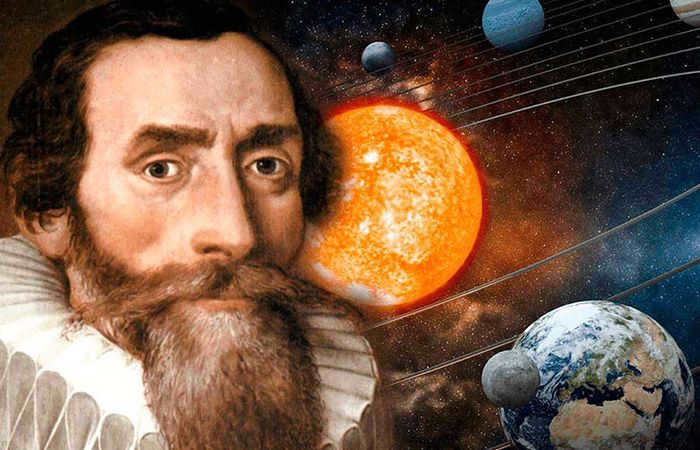
The laws of planetary motion, known as Kepler’s Laws, were discovered by Johannes Kepler, a German naturalist, mathematician, astronomer, astrologer, optician, and Protestant theologian. Kepler’s groundbreaking ideas were way ahead of their time and revolutionized our understanding of the solar system. Similar to his contemporary Galileo Galilei, Kepler embraced the heliocentric worldview proposed by Copernicus. However, he faced significant opposition, not only from the Catholic Church but also from the progressive Protestant community. Despite the lack of support and understanding, Kepler persevered and remained steadfast in his belief in his scientific theories.
Genius’s Early Years
Johannes Kepler came into the world on December 27, 1571, in Weil (now Weil der Stadt) in Württemberg. He was born prematurely and was an extremely frail and ailing infant. At the tender age of seven months, Johannes fell victim to smallpox. Unfortunately, the illness resulted in complications that affected Kepler’s vision.

Johann Kepler’s parents, Heinrich and Katharina Kepler, lived in poverty. When Johann was just five years old, his father, who was a traveling merchant, left the family. Johann’s mother, on the other hand, was the daughter of an innkeeper and successfully took over the family business. She also had a good knowledge of herbs and practiced fortune-telling and herbal medicine in her spare time.
The boy’s financial situation was extremely unstable, leaving him longing for a quality education. However, his exceptional intellect and unwavering determination demonstrated once more that no obstacle is insurmountable. Johann had the opportunity to attend the Latin school in Leonberg, where he excelled in his academic pursuits and was awarded a scholarship to study Protestant theology. Following the completion of his studies at the monastery in 1589, Kepler enrolled at the University of Tübingen.
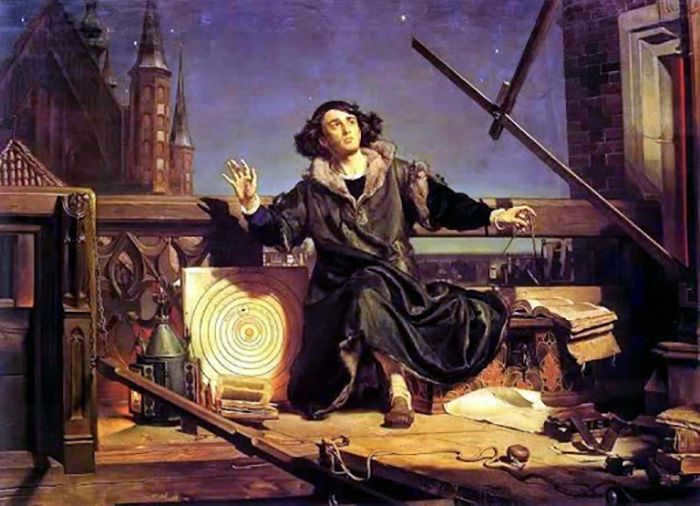
Becoming a scientist
Johann, a young boy, developed a deep fascination for the field of astronomy all thanks to his mother. It was his mother who introduced him to the wonders of the cosmos by showing him a comet back in 1577. This exceptional sight left a lasting impression on the six-year-old, igniting a lifelong passion within him. Just three years later, Johann and his mother witnessed yet another extraordinary astronomical event – a lunar eclipse. Johannes nurtured his love for astronomy throughout his life. In hindsight, the scientist believed that if it weren’t for societal bias against women and their financial constraints, his mother had the potential to receive an education and embark on a scientific career. Kepler, without a doubt, was a son who truly honored his mother’s legacy.
During his time at university, Johann focused his studies in the Faculty of Arts, where he delved into the subjects of mathematics and astronomy. However, his interests eventually shifted towards theology, leading him to undertake a profound exploration of the subject. It was during this time that Johann first encountered the writings of Nicolaus Copernicus, and he quickly became a fervent advocate of Copernicus’ theories. Although Johann initially aspired to become a Protestant priest, his newfound passion for astronomy and his alignment with Copernicus’ ideas caused a significant change in his plans.
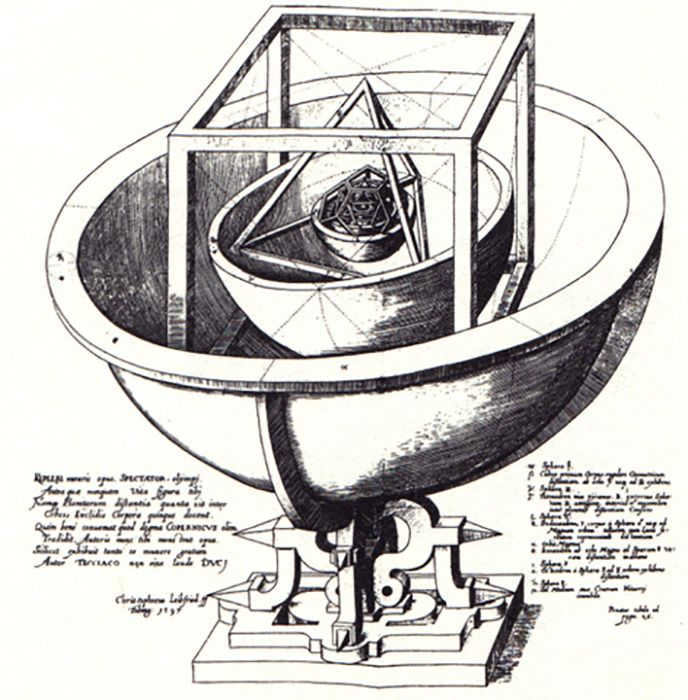
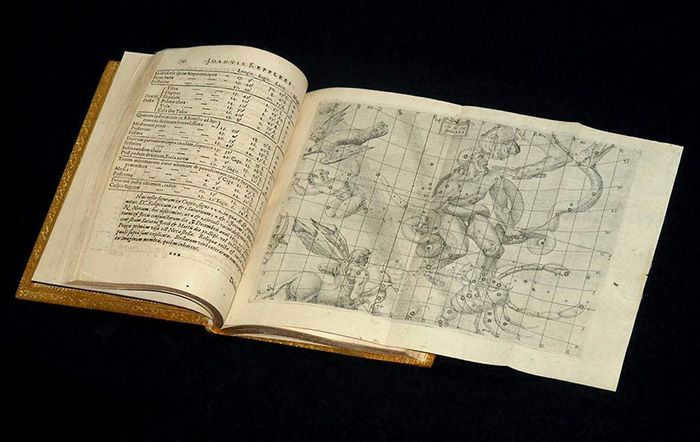
Johannes Kepler’s teachings were based on two fundamental principles: scientific and theological. He consistently approached the study of science through the lens of Scripture, using both Copernicus and biblical verses to support his arguments in favor of the heliocentric theory.
In today’s era of advanced scientific research and high-precision technology, all of Kepler’s discoveries and laws have been thoroughly validated. It is truly awe-inspiring to consider Kepler’s genius, imagination, and unwavering persistence in accurately expressing his ideas, despite not having access to the tools and resources that we have today.
Although Kepler personally regarded astrology as a pseudoscience, he was widely recognized as a highly skilled astrologer. Johannes asserted that individuals were greatly mistaken in believing that celestial bodies had any impact on their lives on Earth. He referred to astrology as the foolish offspring of genuine science, which relies on it for support. Kepler’s astrological forecasts for the year 1594 earned him considerable acclaim, as his predictions of an exceptionally harsh winter and a Turkish invasion were proven accurate.

Personal life
Johannes Kepler’s first marriage was to Barbara Müller in 1597. At the time, she was 25 years old and already a widow with a child. They lived together for nearly 15 years and had a total of five children. Sadly, two of their children passed away in infancy. In 1611, Barbara fell seriously ill, which brought upon a challenging period for Johannes. Around the same time, he also lost his six-year-old son to smallpox and his wife. A year and a half later, Johannes entered into a second marriage with a woman named Susanna. This marriage brought him greater happiness, as his new wife proved to be a loving and caring mother to his children.
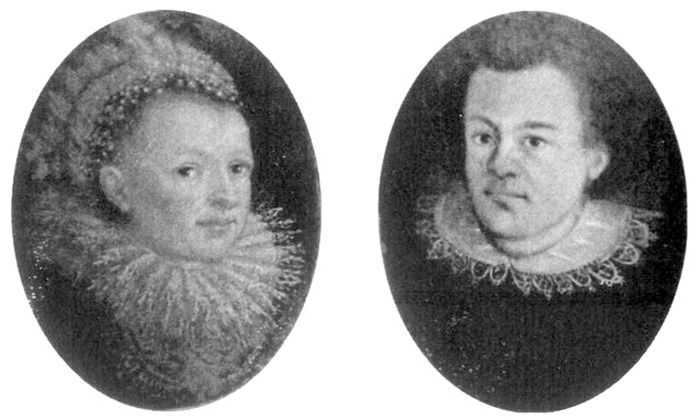
Recognition and expulsion
Johannes Kepler sent his initial scientific work, The Enigmas of the Cosmos, to Galileo and the astronomer Tycho Brahe. Galileo greatly admired Kepler’s heliocentric approach but criticized his mystical numerology. Tycho also did not support it, considering these inventions to be far-fetched. However, he fully appreciated the originality of Kepler’s genius thinking, and they began corresponding with each other. Kepler was unable to engage in a proper debate with Brahe because he lacked the precise data and equipment that the renowned astronomer had at his disposal.
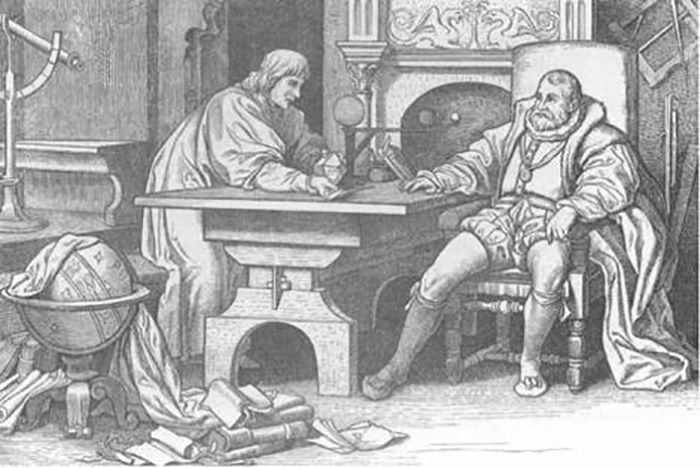
During this period, tensions began to escalate in the town where the scientist and his family resided. The Counter-Reformation made attempts to coerce Kepler into converting to Catholicism, but the scientist stood firm in his refusal and was ultimately compelled to flee. Fortunately, Tycho’s invitation came at just the right time. In 1600, Johann made his way to Prague where he was appointed as the court astronomer for Emperor Rudolf II.

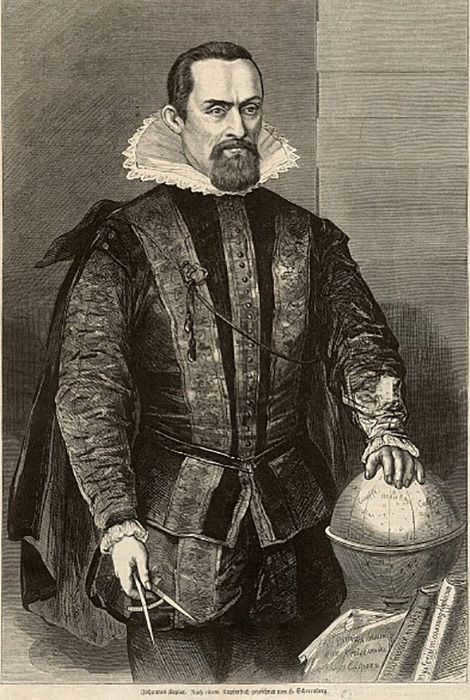
In 1609, Kepler’s elliptical theory led to the publication of his first and second laws of planetary motion. On May 15, 1618, he discovered the third law, which is now named after him, while studying data on the orbit of Mars. This discovery was described in his work Harmonices Mundi libri V (World Harmony). In 1621, Kepler further contributed to the Copernican doctrine by proposing that the force emitted by the Sun is responsible for planetary motion. His mathematical and astronomical insights had a profound impact on the advancement of physics for centuries to come. The results of his research marked a significant shift in the scientific epistemology of modern times, as they were consistently studied and analyzed.
Kepler held the knowledge and experience he gained from scientific observations in higher regard than the conflicting assertions of both church and secular authorities. As a result, he frequently found himself at odds with them. This eventually led to his relocation to Linz in 1611, where he embarked on a career as a mathematician. In 1615, he formulated what is now known as Kepler’s barrel rule, which stands as his most significant contribution to the field of mathematics. This rule was instrumental in the calculation of areas and volumes, and its implications eventually paved the way for the discovery of Simpson’s formula and the development of integral calculus. Between 1618 and 1621, Kepler compiled his findings in his book Epitome Astronomiae Copernicae (Outline of Copernican Astronomy), which served as a comprehensive summary of his discoveries. This groundbreaking work would go on to become the first-ever textbook on the heliocentric worldview.
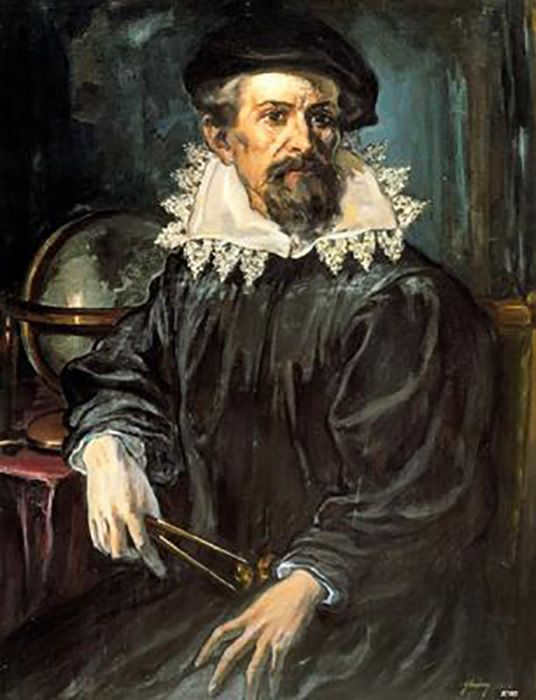
In 1626, due to the influence of the Counter-Reformation and its extremists, the scientist was compelled to depart from Linz. Following several journeys, he published the Rudolfine Tables in 1627, which served as the foundation for astronomical calculations for over three centuries. One year later, Kepler settled in Sagan (Silesia), where he served as a mathematician at the court of Prince Albrecht Wenzel Eusebius von Wallenstein (1583-1634). By introducing logarithmic calculus, he played a role in the dissemination of this new form of calculus in Germany. Kepler also conducted scientific research on optics and aided in the verification of the findings made by his contemporary Galileo Galilei with the use of the telescope.
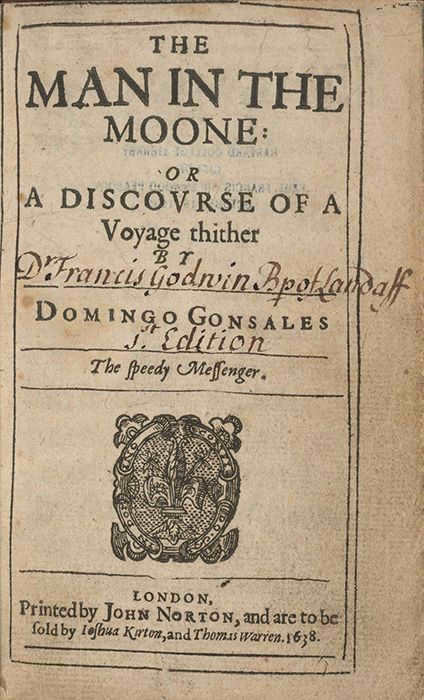
Unraveling the Enigma of Kepler
During the period from 1615 to 1621, Kepler dedicated his efforts to a momentous scientific masterpiece known as “Copernican Astronomy.” This extraordinary opus, consisting of three volumes, meticulously expounded upon the three laws of planetary motion and showcased Kepler’s remarkable discoveries in the realm of astronomy. Astonishingly, these groundbreaking books were swiftly condemned and prohibited.
In those bygone days, an undeniable correlation between science and sorcery was widely accepted by the general populous. Kepler boldly refuted the prevailing belief that the Sun orbited the Earth and fearlessly ventured into the realm of astrophysics, devising a scientific methodology for predicting eclipses. His revolutionary ideas were simply too audacious for the era, and it is no surprise that he found himself accused of practicing witchcraft.

During the 14th and 15th centuries, the continent of Europe was engulfed in a wave of mass hysteria known as the witch-hunt. In this dark period, accusations of witchcraft were all too common. Women, in particular, were often the target of these accusations, and even the slightest suspicion could lead to their execution on charges of “conspiring with the devil”. It was not uncommon for members of the highest echelons of society, including royalty and clergy, to participate in mock exorcisms of these accused women. These rituals often involved the public display of insects crawling out of the mouths of the accused, as they were supposedly being “purged of demons”. Tragically, hundreds of thousands of women were accused of witchcraft during this time, and the vast majority of them were found guilty. They were subjected to brutal torture methods in order to extract confessions, and then ultimately executed.

Katharina Kepler, a renowned herbalist and the mother of Johannes Kepler, found herself caught up in this tumultuous period. As one of the longest-standing residents of the German town of Leonberg, she was well-known for her bold demeanor. Revered for her ability to heal and alleviate suffering through her own homemade herbal mixtures, Katharina’s reputation was tarnished when one of her friends and clients reported her to the Inquisition, accusing her of practicing witchcraft.
In reality, it was quite straightforward. This lady, Ursula Reinhold by name, happened to be the sister of the local barber. She was unfaithful to her husband and ended up getting pregnant. She approached her friend Katharina and asked for assistance in terminating the pregnancy. However, Katharina declined to help. This greatly angered Ursula, and she took matters into her own hands, attempting to have the abortion herself. Unfortunately, it was not successful, and she fell ill as a result. In order to conceal the consequences of her actions, she falsely accused her former friend of placing a curse on her.
As is often the case in small communities, there were many individuals who sought to condemn the woman. One girl alleged that her arm went numb after being struck by Katarina. A schoolteacher claimed to have been victimized by a witch, asserting that she had cast a spell on him and caused injury to his leg. There were others who claimed to have witnessed Katarina walking through closed doors. Numerous individuals accused her of being responsible for the deaths of infants and the spread of disease among livestock.
The suspicions were reinforced by the works of Johann, her son. One of his notable publications was a memoir detailing his journey to the moon. The narrative follows a young astronomer who seeks the aid of his mother, a skilled healer and herbalist with the ability to commune with spirits. This book, believed to be based on Johann’s own experiences, provided substantial evidence to support the accusations. Consequently, Johann’s mother was apprehended.
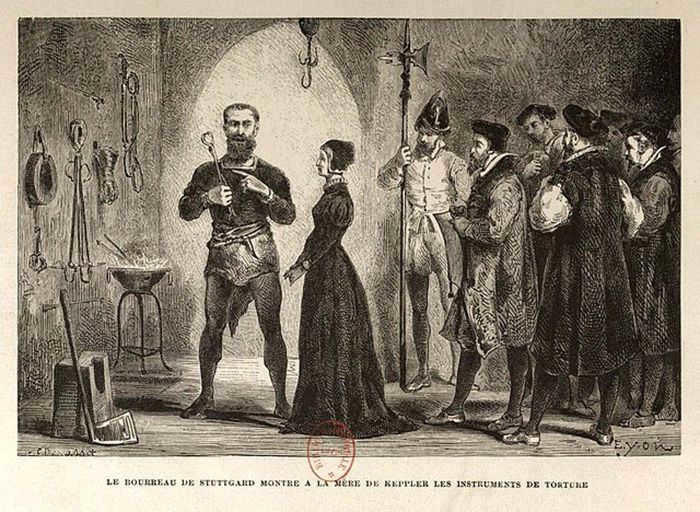
The unfortunate lady endured severe torment and was coerced into admitting to baseless allegations. Fortunately, her son intervened to help. Johann Kepler dedicated himself to defending his cherished mother. He provided evidence that Ursula had indeed undergone a termination of pregnancy. The young girl’s arm became numb as a result of carrying an excessive load of heavy bricks. The teacher developed a limp after stumbling and injuring a joint.
The trial lasted for a year. Eventually, thanks to her son’s heroic efforts, Katharina was cleared of all charges and set free. However, the time spent in prison and the torture she endured had greatly affected her health. Sadly, within a year, she passed away. Kepler dedicated the remainder of his life to providing explanations and clarifications for his book The Dream, ensuring that anything that could be misinterpreted as superstitious was carefully addressed. He added numerous sections where he outlined scientific justifications for the use of his symbols and metaphors. Despite his efforts, there are still those who view Kepler as a magician, believing that he carried his alleged dark secrets to the grave.

Heritage
The scientist’s work remains valuable to this day, particularly in the areas of symmetry, crystallography, and coding theory. Kepler was the pioneer in using the phrase “arithmetic mean” and is credited with creating the first logarithmic table. His contributions to the development of geometry were immense, introducing the concept of the focus of a conic section and an infinitely distant point.
Johannes Kepler is also responsible for introducing the term “inertia” and, like his colleague Galileo, discovering the first law of mechanics. He came close to discovering the law of gravitation, being able to explain it but lacking the mathematical justification. Kepler was the first to propose that the tides were influenced by the moon on the upper oceans, a suggestion that Newton would make a century later.
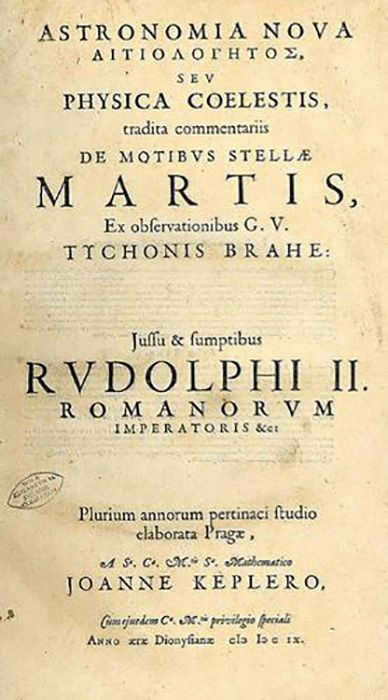
Kepler is credited with the introduction of several important concepts in the field of optics. He was the first to describe the phenomenon of light refraction and to define the concept of the “optical axis” and “meniscus”. Kepler also developed a general theory of lenses and optical systems. In addition, he made significant contributions to the understanding of vision, including the role of the lens and the causes of myopia and hyperopia. It is thanks to his groundbreaking research that the invention of the telescope became possible.
Demise of the Scientist
In 1630, Kepler made the decision to journey to Regensburg to meet with the Emperor and collect his salary. Unfortunately, Johann fell ill with a severe cold during the trip and ultimately passed away. As his legacy, the brilliant scientific mind left behind only worn-out garments, a meager sum of money, and a collection of manuscripts. These manuscripts were later published across 22 volumes. Even in death, the scientist did not have much fortune. The cemetery where he was laid to rest was completely destroyed during the tumultuous Thirty Years’ War, leaving no trace of his grave. Only the epitaph he penned himself remains as a testament to his life: “I traversed the expanse of the heavens, and now I measure the length of shadows. While my thoughts reside in the celestial realm, my physical form finds solace in the earthly realm.”

Throughout history, there have been numerous brilliant individuals who have been misunderstood, undervalued, and even persecuted by their contemporaries. Take a look at our article on the unfortunate downfall of genius: The Troublesome Journey of Nikola Tesla.
Did you find the article interesting? If so, show your support by giving it a click:
“Kepler’s Laws” – a phrase that resonates with anyone interested in astronomy. Who exactly was this man? What did he describe about the connection and interdependence of objective reality? Johannes Kepler (1571-1630), an astronomer, mathematician, theologian, philosopher, and one of the brightest minds of his era, uncovered the laws governing the motion of planets within the solar system.
The start of the journey
Johannes Kepler, born in Weil der Stadt, Germany, arrived on this planet in December 1571. Despite being weak and visually impaired, he overcame all obstacles to achieve success in his life. His education began in Leonberg, where his family had relocated. Later, he attended a more advanced institution – a Latin school, where he studied the fundamentals of the language that he would later use in his future writings.
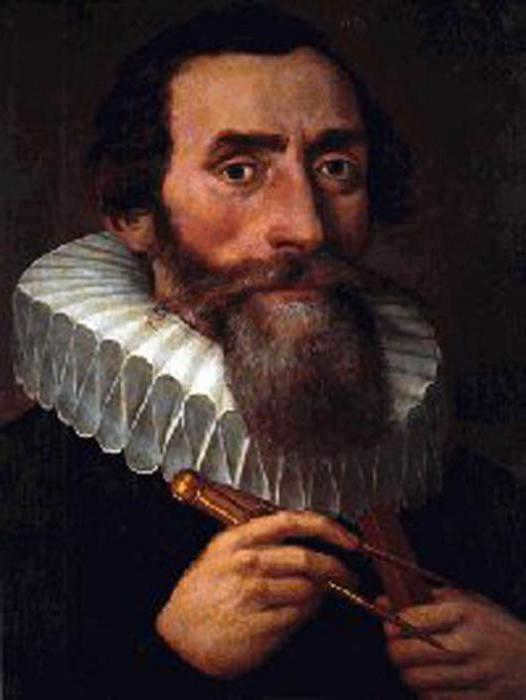

After completing his studies at the Maulbronn monastery in Adelburg in 1589, he enrolled at the University of Tübingen in 1591. The introduction of Lutheranism led to the establishment of an effective educational system by the dukes. They provided grants and scholarships to support disadvantaged students, with the aim of producing well-educated clergymen who could defend the new faith during religious disputes.
During his time at the institution, Kepler was influenced by his astronomy professor, Michael Möstlin. Möstlin secretly held the same beliefs as Copernicus about the heliocentric universe, but he taught his students based on the geocentric model. Kepler’s extensive understanding of Copernicus’ ideas sparked his interest in astronomy, and he became a supporter of Copernicus’ theory. He was determined to personally grasp the laws of planetary motion around the Sun.
The solar system is a masterpiece
Odd as it may appear, the individual who subsequently unraveled the principles of planetary motion did not identify himself as an astronomer by calling. Kepler, throughout his existence, viewed the solar system as a masterpiece, brimming with mystical phenomena, and aspired to become a priest. The astronomer justified his fascination with the Copernican theory by asserting that, prior to drawing conclusions from his own investigations, he ought to examine diverse perspectives.

However, Kepler was highly regarded by his university professors for his exceptional intellect. After obtaining his master’s degree in 1591, the scholar decided to pursue further studies in theology. As he neared the end of his theological studies, news spread about the passing of a mathematics professor at the Lutheran school in Graz. The University of Tübingen suggested that a highly skilled alumnus be appointed to fill the vacant position. Thus, Kepler bid farewell to his studies on planetary motion.
In the name of the Almighty
Johann, who was 22 years old at the time, reluctantly decided to abandon his original calling to become a priest. However, he still embraced his new role as a mathematics professor in Graz. While delivering a lecture to his class, the young teacher was sketching geometric figures on the blackboard, specifically concentric circles and triangles. Suddenly, a realization struck him – these figures exhibited a consistent ratio between the sizes of two circles, as long as the triangle was equilateral. He pondered further, wondering about the ratio of the areas between the two circles. His thought process began to intensify.
One year later, this remarkable theologian released his inaugural publication, The Enigma of the Cosmos (1596). Within its pages, he expounded upon his innovative perspectives regarding the mysteries of the universe, all supported by his unwavering religious beliefs.
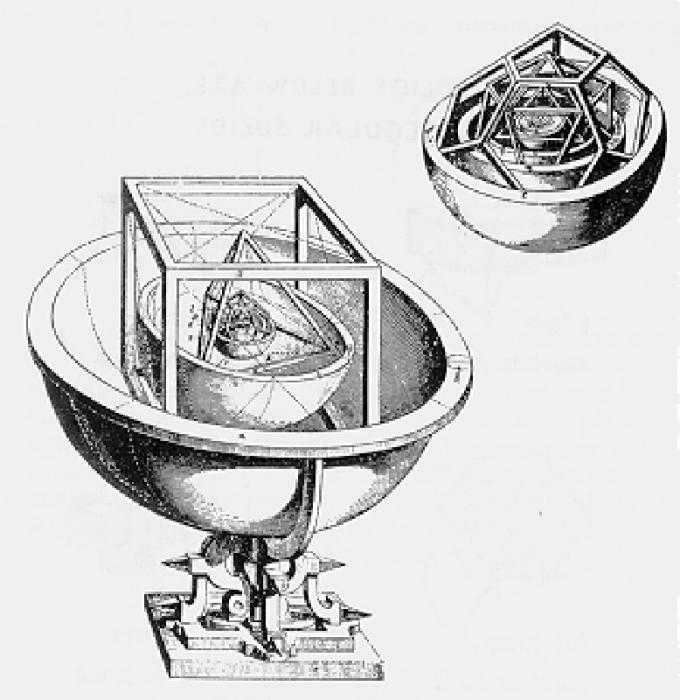
The laws of planetary motion were discovered by an individual who attributed their findings to a higher power. By revealing the mathematical blueprint of the universe, this researcher concluded that the six planets are contained within spheres, with five regular polyhedrons fitting in between. It is important to note that this theory was based on the assumption that there are only six celestial bodies. Kepler proposed the idea of a perfect dodecahedron surrounding the orbit of Earth and a sphere that touches the orbit of Mars.
Impeccable polyhedra
In the vicinity of Mars, the scientist illustrated a tetrahedron and a sphere that were adjacent to the orbit of Jupiter. The icosahedron in the orbital sphere of Earth perfectly “fits” the sphere of Venus. The remaining types of impeccable polyhedra were used in the same way. Surprisingly, the proportions of neighboring planetary orbits presented in Kepler’s nested model of the spheres coincided with Copernicus’ calculations.
When discovering the laws of planetary motion, a priest with a mathematical mind primarily relied on divine inspiration. He had no tangible basis for his arguments. The significance of the treatise “Mysteries of the Universe” lies in the fact that it was the first definitive step towards the acceptance of the heliocentric system of the world proposed by Copernicus.
Comparing Assumptions to Achieving High Precision
By September 1598, the Catholic rulers in Graz had expelled the Protestants, including Kepler. Despite being eventually permitted to return, the atmosphere remained highly charged. In search of assistance, Kepler sought out Tycho Brahe, an esteemed mathematician and astronomer in the service of Emperor Rudolf II. Brahe was renowned for his extensive records of planetary observations.
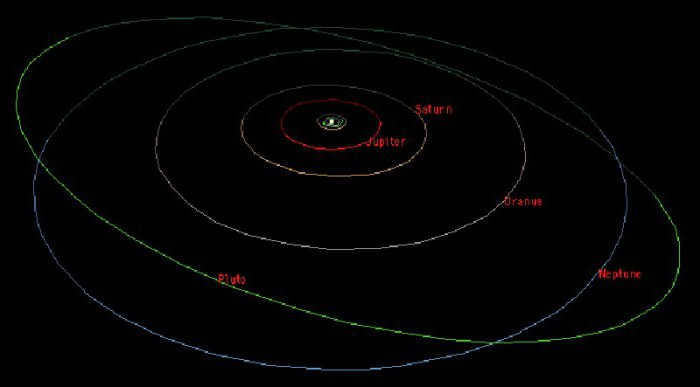
The Mystery of the Universe was a well-known work to him. However, upon his arrival at the Tycho Observatory near Prague in 1600, Brahe, who was conducting remarkably accurate (for that era) research, greeted him as the author of a specific work, but not as his colleague. The conflict between them persisted until the Danish astronomer’s death a year later. Following his rival’s departure to the afterlife, Kepler was entrusted with the safekeeping of his observations. These observations proved immensely valuable and aided the researcher in becoming the individual who uncovered the laws governing the motion of planets around the Sun.
The journey of Mars
Brahe’s final endeavor to construct a chart of the planets’ movements remained unfinished. All expectations now rested on a successor. Kepler, who had been appointed imperial mathematician, was at liberty to pursue his own astronomical pursuits, despite the strained relationship he had with his late colleague. Determined to carry on his investigations of Mars, Kepler set out to present his own interpretation of the planet’s orbit.
Johann was certain that by uncovering the intricate trajectory of Mars, he could unveil the paths of all other celestial bodies. Contrary to common belief, he did not merely rely on Brahe’s observations to choose a geometric shape that matched the description. The former theologian dedicated himself to finding a tangible theory explaining the movement of these “sisters dwelling in vacuum” and how their orbits could be derived from it. Following an immense research endeavor, he formulated three laws governing the motion of planets.
I. The planets follow elliptical paths with the Sun positioned at one of the focal points.
The principle governing the movement of planets within the solar system dictates that they trace out an elliptical trajectory. This discovery was made after an extensive eight-year calculation process, using a dataset compiled by Tycho Brahe from his observations of the planetary motion of Mars, and was subsequently published by Johannes Kepler under the title “The New Astronomy”.
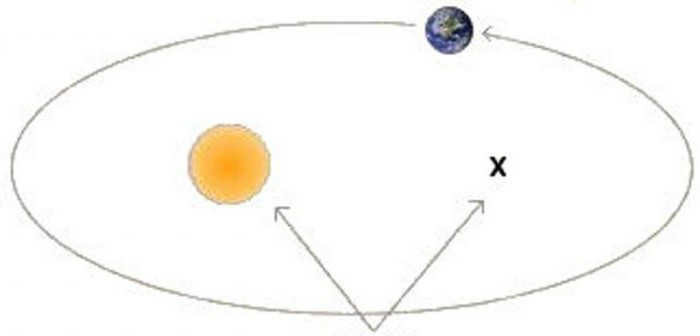
Therefore, as per Kepler’s First Law, every ellipse possesses two foci, which are geometric points. Irrespective of the planet’s position on its path of motion, the combined distance from the planet to each of the foci always remains the same. The significance of this discovery lies in the fact that it brought people closer to a more precise and clearer understanding of the world, as it challenged the assumption that orbits are perfect circles (as believed in the geocentric theory).
The Law of Equal Areas
II. The planet’s radius-vector, which connects it to the Sun, covers equal areas in equal time intervals while the planet orbits in an elliptical path.
Put simply, no matter what time period you choose, such as 30 days, the planet will cover the same area. As it moves around its orbit, the planet’s speed changes – it moves faster when it approaches the Sun and slower when it moves away. The speed of the planet is constantly changing throughout its orbit. The planet’s fastest motion occurs at perihelion, the point nearest to the Sun, while its slowest motion is observed at aphelion, the point farthest from the Sun. These observations were made by the individual who first discovered the laws governing planetary motion.
The Law of Orbital Period
III. According to this law, the square of the orbital period (T) is directly proportional to the cube of the average distance from the planet to the Sun (R).
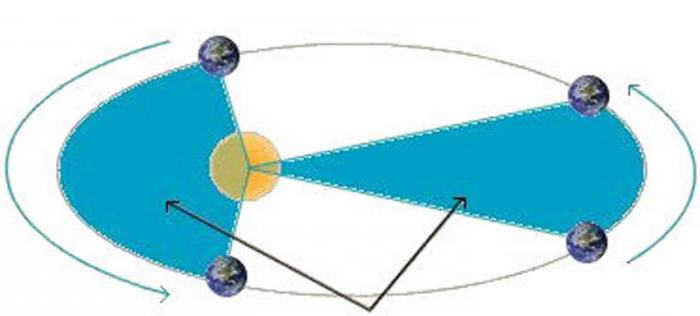
This principle is sometimes referred to as the law of concordance. It compares the time it takes for a planet to complete one orbit around the sun and the distance between the planet and the sun. Kepler’s discovery can be summarized as follows: the ratio of the squares of the orbital periods to the cubes of the average distances from the sun is the same for every planet.
Once again, Kepler’s laws of planetary motion were based on extensive and meticulous observations, as well as mathematical analysis. By revealing these patterns, they did not explain the underlying causes of the phenomena. It was later Newton, the renowned discoverer of the law of universal gravitation, who demonstrated that the key lay in the physical property of bodies being attracted to one another.
Despite achieving success, Kepler faced constant financial difficulties, a lack of time for his research, and the challenge of finding a place where his religious beliefs would be accepted. He made multiple attempts to secure a teaching position in Tübingen, but his status as a renegade Protestant resulted in rejection.
Johannes Kepler passed away on November 15, 1630, after suffering from an acute fever. He was laid to rest in a Protestant cemetery. In his epitaph, his legitimate son wrote: “Once I used the heavens as my measuring tool, but now I must measure the shadows of the earth. While my soul resides in heaven, the shadow of my body rests here.”
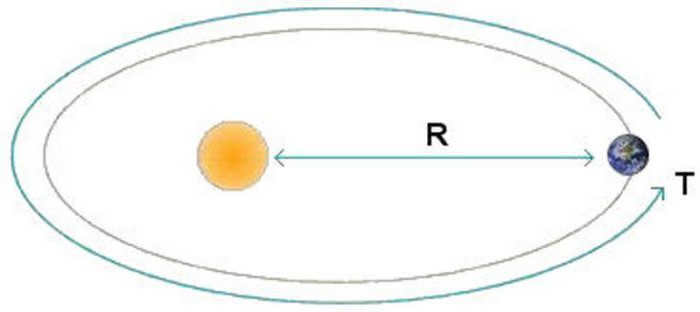
Indeed, initially, in accordance with medieval beliefs, the scientist held the view that planets are propelled by their souls, that they possess a magical essence, rather than being mere physical entities. However, he eventually recognized the validity of the scientific approach. Thus, the clergyman and astronomer who uncovered the principles governing planetary movement embarked on a genuine journey of enlightenment. Nevertheless, let us acknowledge the fact that at times, the thoroughly scientific Universe appears to be imbued with a significant amount of mysticism!
The size and velocity of the Universe are truly astounding. Everything within it – stars, planets, asteroids, stardust – is in perpetual motion. Numerous celestial bodies share similar paths of movement due to the application of universal laws. The solar system’s trajectory within the Galaxy possesses its own distinct characteristics that may initially appear peculiar, yet it still adheres to the same laws governing other celestial objects.
A concise account of the history of astronomy
There was a time when people held the belief that the Earth was flat and had a crystal cap, to which the stars, Sun, and Moon were attached. In ancient Greece, the influential works of Ptolemy and Aristotle propagated the idea that the Earth was spherical, and all other celestial bodies revolved around it. However, in the 17th century, skepticism arose regarding the Earth’s central position in the universe. Through their observations of planetary motion, Copernicus and Galileo concluded that the Earth, along with the other planets, orbited the Sun.
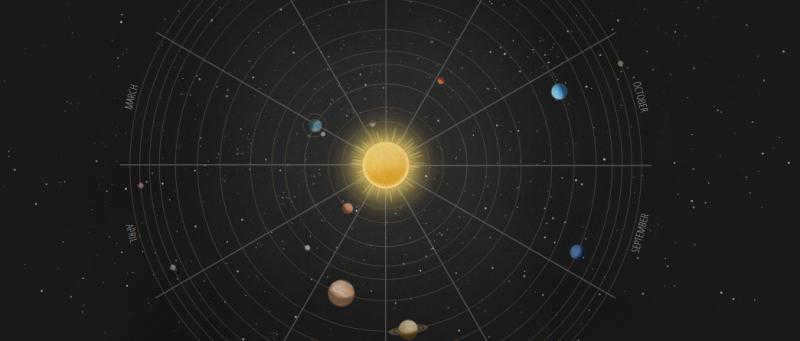
Scientists in recent times have made a remarkable discovery that challenges previous beliefs about the position of our solar system. It was once thought that the Sun was the central point, with the planets revolving around it. However, further research has revealed that this is not entirely accurate. Observations from telescopes in Earth’s orbit have shown that our galaxy, the Milky Way, is not the only one in existence. In fact, there are billions of galaxies, each with their own clusters of stars and clouds of cosmic dust. The Milky Way itself is also in motion, moving relative to these other galaxies and celestial bodies. This new understanding highlights the vastness and complexity of the universe we live in.
The Sun is responsible for the movement of the solar system within the Milky Way Galaxy. The Sun follows an elliptical path, which is almost perfectly circular, and exerts gravitational force on the planets and asteroids that constitute the system. In addition to orbiting around the center of the Milky Way, the Sun also rotates on its own axis. The axis of the Sun is tilted at an angle of 67.5 degrees. This tilt causes the Sun to appear as if it is lying on its side, resulting in the perception that the planets in the solar system are rotating in a vertical plane rather than an inclined one. The Sun rotates in a counterclockwise direction around the center of the Galaxy.
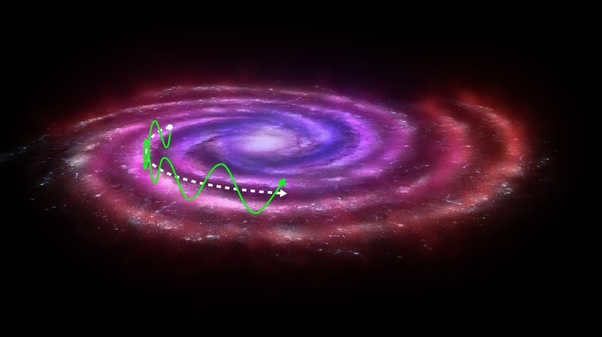
The solar system also undergoes vertical movements, sinking or rising relative to the center point approximately every 30 million years. This peculiar trajectory within the galaxy might be attributed to the rotational movement of the Milky Way’s core, which periodically tilts like a wolf. The Sun simply follows these movements, as it is bound by the laws of physics to travel along the equator line of the galaxy’s central body, where scientists believe a massive black hole resides. However, it is possible that other large celestial bodies exert their influence and contribute to this trajectory.
The velocity of the solar system within the Milky Way is equivalent to the velocity of the Sun, which amounts to approximately 250 km/s. The solar system completes a full orbit around the galactic center every 13.5 million years. Throughout the entire timeline of the Milky Way Galaxy, the Sun has successfully completed three full rotations.
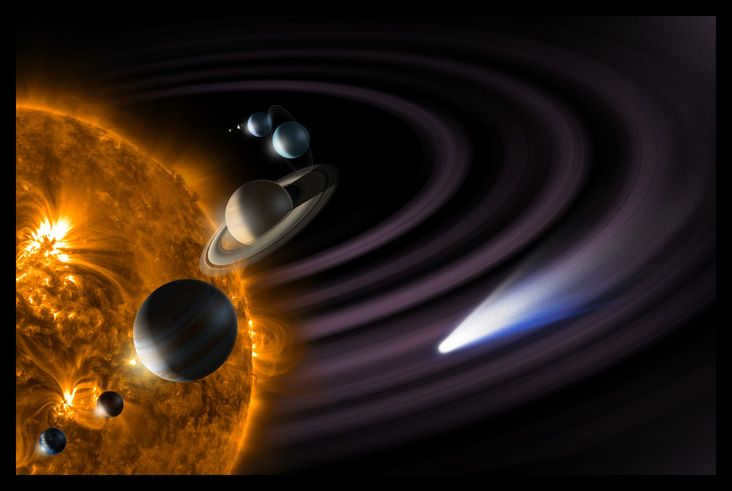
Motion Principles
When calculating the speed at which the Solar System moves around the center of the Galaxy and the planets that compose it, it is important to consider that the laws of motion, such as Newton’s law of gravitation, are in effect within the Solar System. However, when determining the trajectory and velocity of the planets around the center of the Galaxy, Einstein’s theory of relativity also comes into play. As a result, the velocity of the Solar System corresponds to the orbital velocity of the Sun, given that approximately 98% of the system’s total mass is concentrated within the Sun.
Kepler’s second law is followed by its movement within the Galaxy. In the same way, this law is obeyed by the planets of the solar system. According to this law, all of them orbit in a common plane around the Sun’s center.
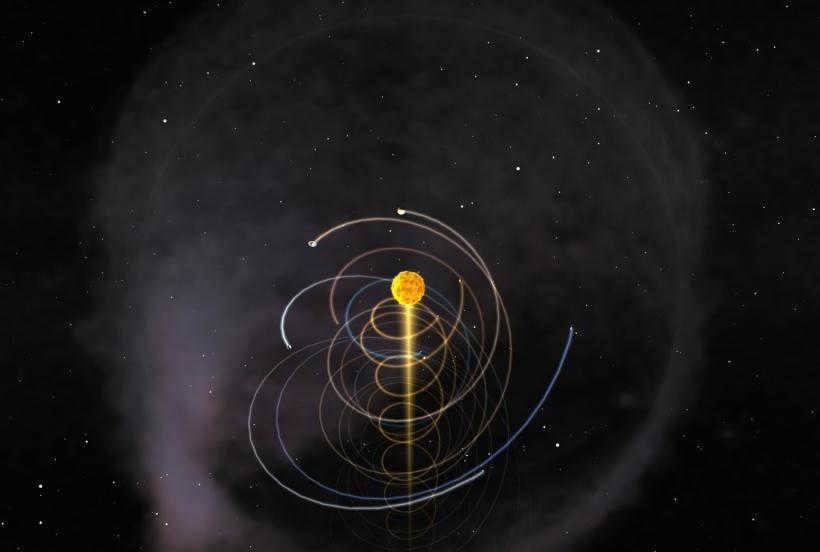
Towards or Away from the Center?
Aside from the fact that all stars and planets revolve around the central point of the Galaxy, they also possess other directional movements. For a considerable period of time, scientists have determined that the Milky Way galaxy is undergoing expansion, albeit at a slower pace than expected. This discrepancy has been ascertained through computer simulations. The divergence has long perplexed astronomers, until the existence of dark matter was confirmed, preventing the Milky Way galaxy from disintegrating. However, the movement away from the center persists. In other words, the solar system not only orbits in a circular motion, but it also shifts in the opposite direction, moving away from the center.

Movement in boundless space
Our galaxy is also in motion in space. Scientists have discovered that it is advancing towards the Andromeda Nebula and will eventually collide with it in a few billion years. Simultaneously, the motion of the Solar System within the galaxy is in the same direction, as it is an integral part of the Milky Way, moving at a speed of 552 km/s. Its speed of movement towards the Andromeda Nebula is much greater than its orbital speed around the galactic center.
Reasons for the stability of the solar system
Contrary to popular belief, the vast expanse of outer space is far from empty. Instead, it is teeming with cosmic dust and mysterious dark matter, which permeate all galaxies. These cosmic dust particles and dark matter form vast clusters known as clouds and nebulae. Remarkably, these clusters often envelop massive celestial bodies like stars and planets, playing a crucial role in maintaining the stability of the solar system.
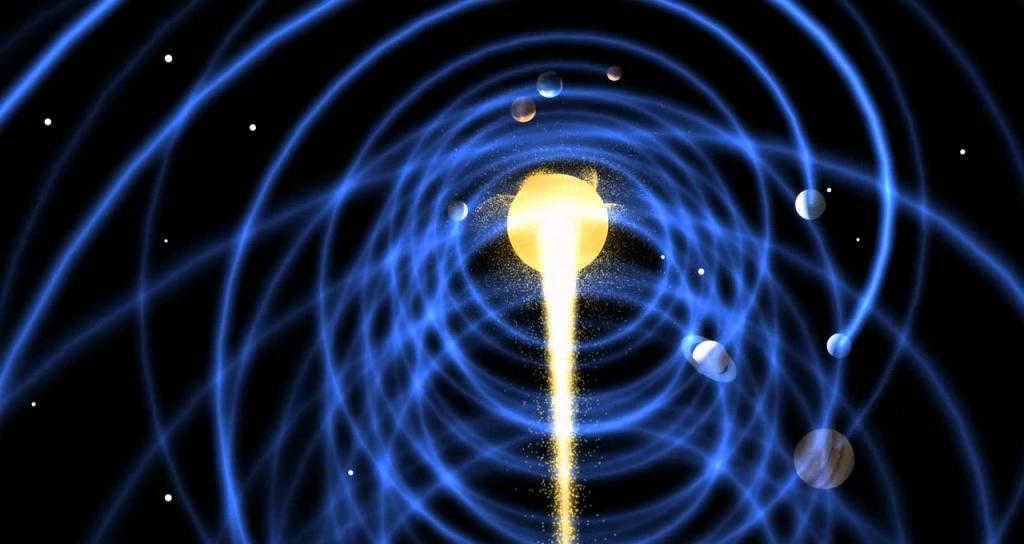
The solar system is surrounded by similar clouds, which contribute to its structural integrity by creating an elastic body effect. Additionally, the strong gravitational interaction between the Sun and the planets, along with the substantial distance to the nearest stars, prevents the collapse of the Solar System. To put the vastness of this distance into perspective, consider that the closest star to the Sun, Sirius, is approximately 10 million light-years away. This distance can be contrasted with the comparatively short 8.6 light minutes it takes for light to travel from the Sun to Earth. As a result, the gravitational forces exerted by the Sun on other celestial bodies within the solar system are significantly more pronounced than those exerted by other stars.
The movement of objects within the solar system occurs in two directions: orbiting the Sun and revolving with it around the center of the Milky Way. All celestial bodies in this system move in two planes: along the equator and around the center of the galaxy, mirroring the movements of the Sun, including those in the vertical plane. This movement occurs at an angle of 60 degrees in relation to the galactic center. Observing the trajectory of the planets and asteroids within the solar system, their motion takes on a spiral pattern. The planets follow a path that trails behind and encircles the Sun. This spiral trajectory of planets and asteroids ascends in conjunction with the Sun every 30 million years, and descends in a similarly smooth manner.
The movement of the planets within the solar system
In order to fully understand the dynamics of the solar system within the galaxy, it is essential to consider the speed and orbit of the planets as they revolve around the Sun. All planets move in a counterclockwise direction, both in their orbit around the Sun and in their own rotation, except for Venus. Additionally, many planets have multiple satellites and rings. The further a planet is from the Sun, the more elongated its orbit becomes. For example, the dwarf planet Pluto has an extremely elongated orbit that brings it closer to the Sun than Uranus when it reaches perihelion. Each planet has its own specific orbital velocity around the Sun:
- Mercury – 47.36 km/s;
- Venus – 35.02 km/s;
- Earth – 29.02 km/s;
- Mars – 24.13 km/s;
- Jupiter – 13.07 km/s;
- Saturn – 9.69 km/s;
- Uranus has a speed of 6.81 km/s;
- Neptune has a speed of 5.43 km/s.
There is a clear trend: the further a planet is from the sun, the slower its speed and the longer its path. This means that the spiral motion of the Solar System has the highest speed near the center and the lowest speed at the outskirts. Before 2006, Pluto was considered the outermost planet with a speed of 4.67 km/s, but it was reclassified as a large asteroid – a dwarf planet.
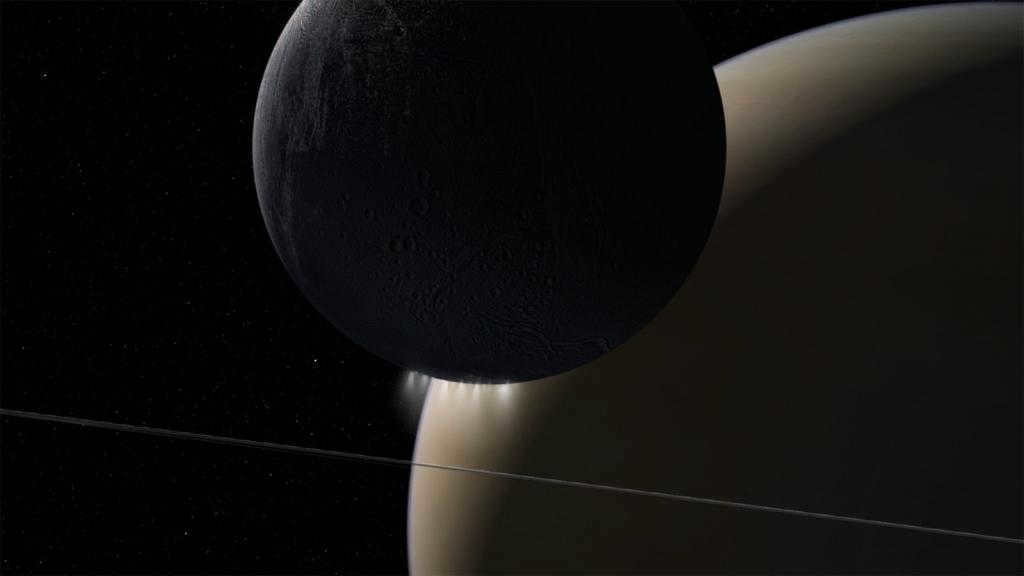
Planets have an irregular movement pattern as they travel in elongated orbits. The speed at which they move is determined by their position within their orbit. For example, when a planet is at perihelion, its linear velocity is higher compared to when it is at aphelion. Perihelion refers to the point in the planet’s elliptical trajectory that is farthest from the Sun, whereas aphelion is the point closest to the Sun. As a result, the velocity of the planets may vary slightly.
Summary
Earth, one of the countless grains of sand in the vast expanse of space, follows specific laws of motion within the solar system. Gravity is the primary force governing its movement, influenced by two key objects: the Sun, the closest star, and the center of the Galaxy, around which the solar system and its planets orbit. In terms of its velocity in the universe, Earth, like other stars and planets, is steadily moving towards the Andromeda Nebula at an impressive speed of 552 km/s.
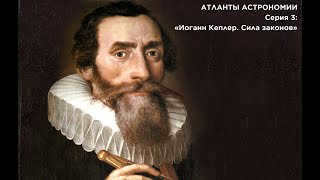
Johannes Kepler, a remarkable German scientist, astronomer, optician, mathematician, and mechanic, made the groundbreaking discovery of the laws governing the movement of the planets in the solar system.
The genius of Kepler’s thoughts and findings was truly ahead of his time. Despite facing skepticism and a lack of support, he dedicated himself to his discoveries and firmly believed in their validity. Today, with the aid of advanced scientific techniques and technology, Kepler’s laws have been confirmed by numerous modern scientists. It is truly awe-inspiring to consider the determination and imagination with which Kepler was able to articulate his discoveries.
Johannes Kepler’s birth coincided with the celebration of St. John the Evangelist’s Day on December 27, 1571, in the town of Wal der Stadte in Germany. The young boy’s father, Heinrich Kepler, served as a mercenary in the Spanish Netherlands. Tragically, when Johann turned 18, his father mysteriously disappeared and is believed to have been killed. In order to make ends meet, Johann’s mother, Katharina Kepler, took on the responsibility of managing the family inn while also working as an herbalist and fortune-teller. Prior to Johann’s arrival, the family already had three children, and their financial situation was quite precarious.
Kepler developed a passion for astronomy at a young age, thanks to his mother. In 1577, his mother introduced him to the fascinating world of astronomy by observing a comet together. This experience left a lasting impact on the young Kepler, who was only six years old at the time. Their shared interest in the stars continued in 1580 when they witnessed a lunar eclipse together.
However, Kepler faced a challenge in his pursuit of astronomy. As a child, he suffered from smallpox, which left him with a visual impairment. This visual defect made it more challenging for him to carry out astronomical observations. Nevertheless, Kepler’s love for the subject persevered throughout his life.
In 1589, Johann completed his education at the Maulbronn monastery school. He demonstrated exceptional academic abilities and was granted a scholarship by the town council for further studies. In 1591, he successfully passed his exams and gained admission to the Tübingen institute. Johann initially enrolled in the Faculty of Arts, which focused on mathematics and astronomy during that period. However, he later switched to theology, where he first encountered the works of Nicolaus Copernicus and became an advocate of his theory.
Johann initially aspired to become a Protestant clergyman. However, due to his exceptional aptitude for mathematics, he was offered a teaching position at the university in Graz. He remained there for a span of six years, during which he authored his inaugural book, The Enigma of the Cosmos. This publication was released in 1596, wherein the author endeavored to decipher the celestial harmony. Specifically, he compared the circular orbits of the five planets known at that time. Subsequently, through subsequent works and discoveries, this scientific endeavor somewhat diminished in significance, as the scientist later proved that planetary orbits are not truly circular. Nevertheless, Kepler maintained his belief in the existence of mathematical harmony within the universe until the end of his days. In 1621, Johannes republished his work, incorporating significant modifications, additions, and supplementary information.
Science
Kepler, as a scientist, was undoubtedly influenced by his studies in the theological faculty, which led to his teachings being grounded in both scientific and theological principles. In his works, one can observe the interpretation of laws through the lens of religious nuances, although he never prioritized the “divine” over scientific principles.
Even during his time as a student, young Kepler successfully demonstrated the validity of the heliocentric system in debates with his colleagues, drawing upon the astronomical and theological writings of Copernicus.
Kepler sends his first book, The Mysteries of the Universe, to Galileo and the astronomer Tycho Brahe. Galileo commended Johannes’ heliocentric approach but criticized his mystical numerology. Quietly, Galileo did not support Kepler’s far-fetched constructions. Brahe admired the scientist’s innovative thinking. Their correspondence continued, engaging in a debate on various astronomical problems. Many of the issues discussed in the correspondence were beyond Kepler’s ability to study, as he lacked accurate data that Tycho possessed. Tycho used high-precision equipment at his observatory, which Kepler did not have access to.
As time goes on, Johannes comes to realize that his research is leading him nowhere. By 1599, he is certain that he must accept his colleague’s invitation. Unfortunately, the circumstances in Graz are not ideal for continuing his work. The city is experiencing a rise in religious tensions, and Brahe is even expelled from his observatory. This forces him to leave for Prague, where he becomes the court astronomer for Emperor Rudolf II.
In 1600, the two exiles reunite in Prague. Spending two months as Tycho’s guest helps Johannes make the final decision to move to this city. They agree to officially collaborate, and Johann returns to Graz to bring his family with him.
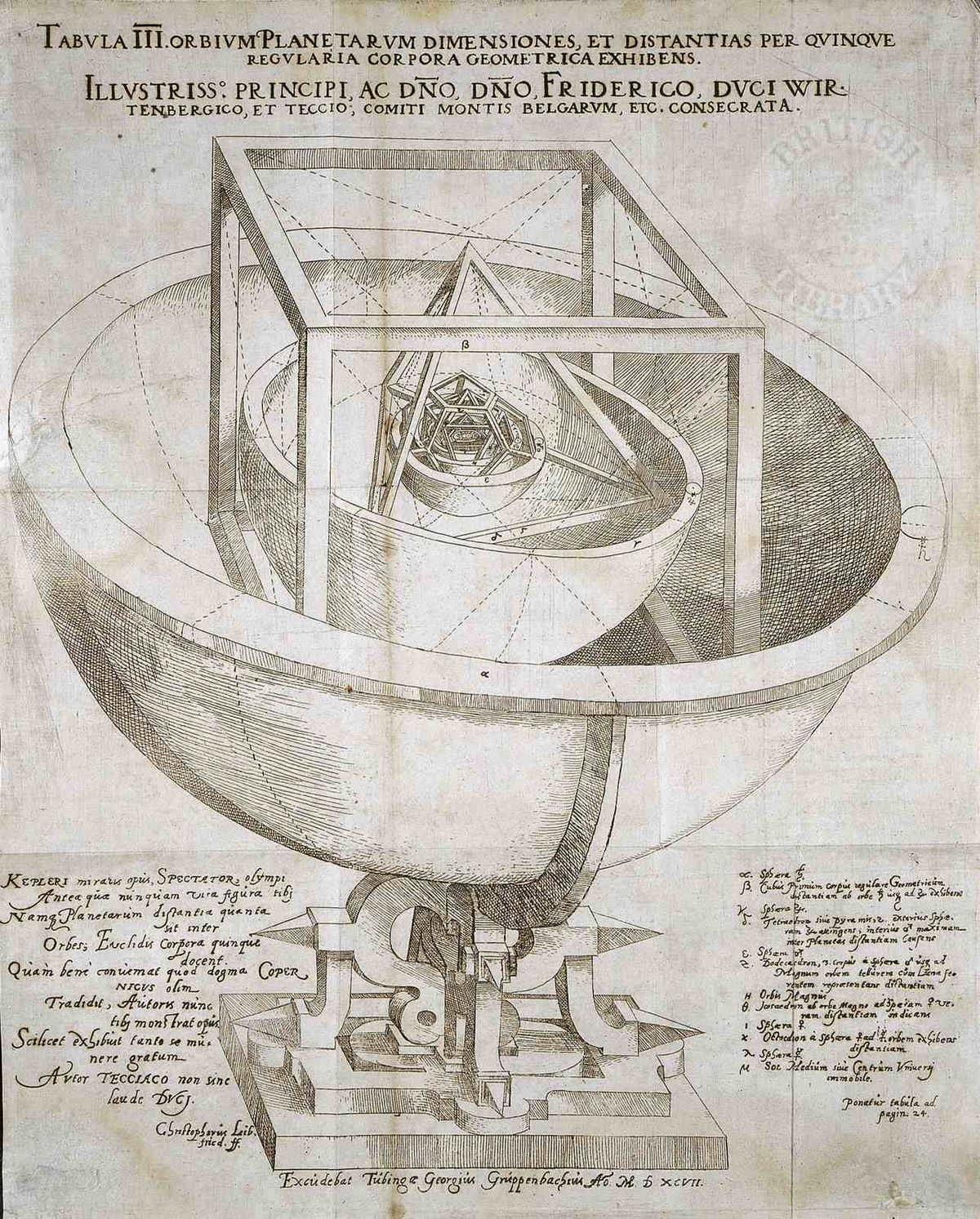
Having witnessed inexplicable visual phenomena during a solar eclipse in his childhood, Kepler was inspired to delve into the study of this phenomenon. Thus, in 1603, he embarked on his exploration of optical theory. The fruits of his labor materialized in the form of the book Optics in Astronomy, penned in 1604, which he subsequently bestowed upon the emperor.
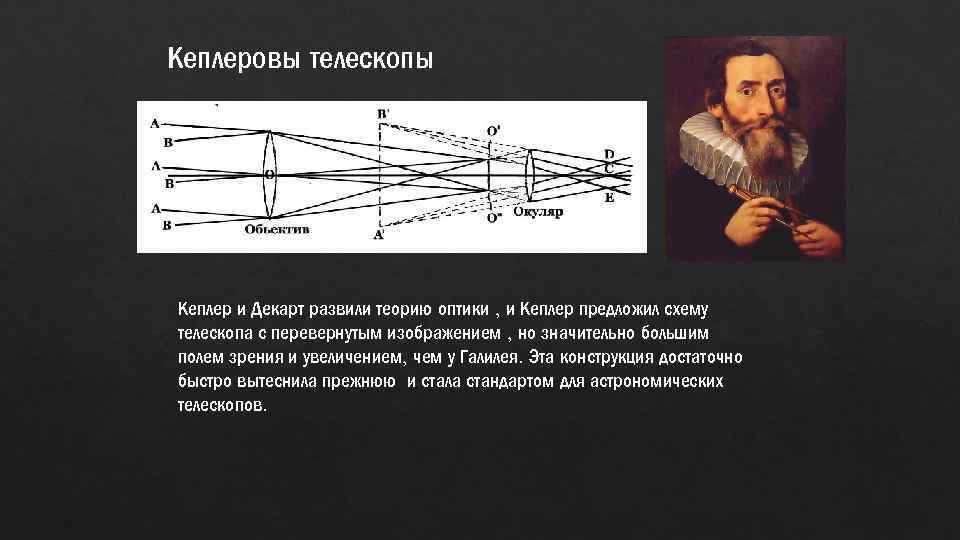
In 1604, Johannes Kepler published his long-standing observations of the supernova, which would later be named after him. The renowned observer, Tycho Brahe, left behind a vast collection of his observations on Mars from years of dedicated work. Kepler utilized these observations to gain a deeper understanding of various astronomical phenomena. After careful analysis of Tycho’s data, Kepler concluded that the path of Mars is not a perfect circle, but actually an elliptical orbit. Through further studies, Kepler established two fundamental laws of planetary motion, which are now known as Kepler’s laws. These laws were officially formulated by the scientist in 1609. Initially, Kepler only attributed his discovery to Mars as a precautionary measure. The resulting book was titled “The New Astronomy.”
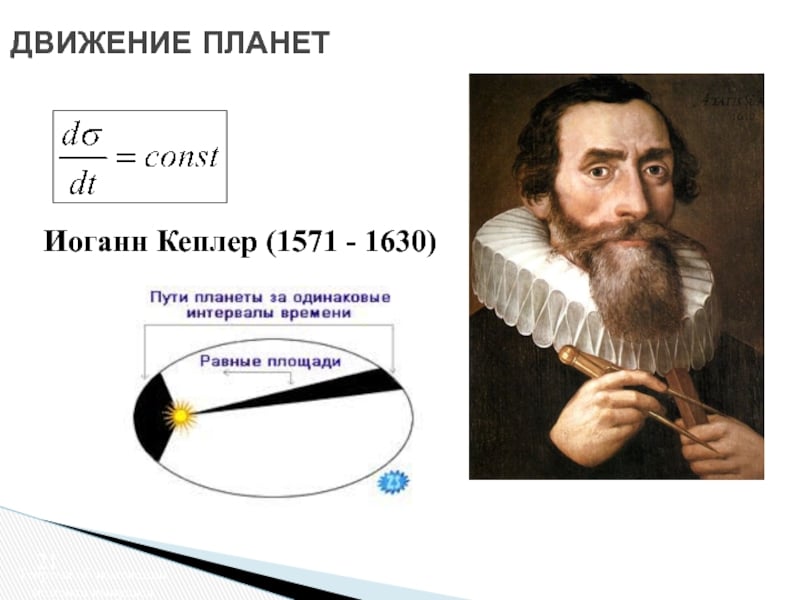
In 1611, Kepler penned the “The Dream, or Posthumous Essay on Lunar Astronomy”, an extraordinary tale of a journey to the Moon. This may have been the first foray into the realm of science fiction. Kepler provided a celestial perspective on the events. It wasn’t until after the author’s passing that readers were able to experience this masterpiece.
From 1615 to 1621, Johannes focused on his work on Copernican Astronomy, a trilogy that was eventually published. Within these volumes, Kepler documented his groundbreaking discoveries, including the three laws of planetary motion. Unfortunately, these books were promptly placed under a ban.
Revolutionary Advances in the Field of Mathematics
While immersed in the world of astronomy, Kepler did not neglect his mathematical prowess. One of his groundbreaking contributions was the introduction of a calculus-like method for calculating the volume of rotation bodies. Furthermore, through meticulous examination of the symmetry found in snowflakes, Johannes Kepler deduced that the most efficient arrangement of balls would be in a pyramidal structure, a theory that was ultimately validated four centuries later.
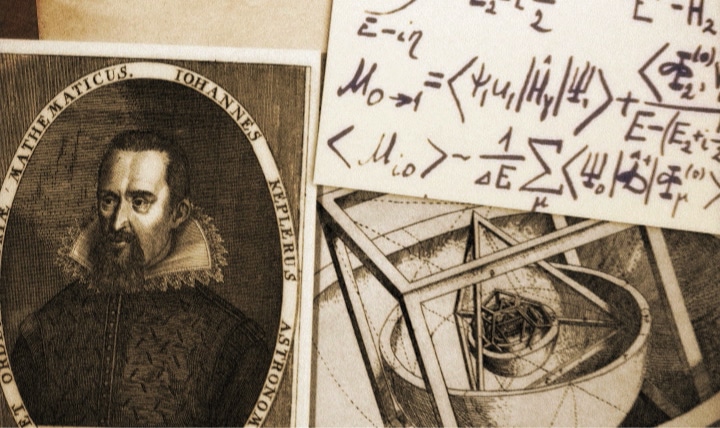
In contemporary times, Johannes Kepler’s investigations into symmetry have found practical applications in the fields of crystallography and coding theory. Additionally, his groundbreaking work on mathematics introduced the term “arithmetic mean” and he is widely recognized for creating the first logarithm table. Kepler also made significant contributions to the advancement of geometry, including the introduction of the concept of the focus of a conic section and the notion of an infinitely distant point.
Physics and mechanics
Johannes Kepler coined the term “inertia” and, similar to his contemporary Galileo, unveiled the initial principle of mechanics. Kepler also made significant progress in understanding the law of gravitation, although he was unable to provide a mathematical explanation. Additionally, he was the first to propose that the moon’s influence on the upper layers of the oceans caused the ebb and flow of tides. It took another century for Newton to make a similar suggestion.
Optics
In 1604, Kepler released his initial publication on optics, titled “Supplement to Vittelius.” In 1611, he followed it with “Dioptrica.” These two works played a pivotal role in establishing optics as a scientific discipline. Within these books, Kepler delved into both geometrical and physiological optics. He introduced the concept of light refraction, the notion of an “optical axis,” the significance of the “meniscus,” and provided a foundation for understanding lenses and optical systems. Kepler’s comprehensive account of vision aligns closely with modern research. He not only defined the function of lenses but also offered explanations for nearsightedness and farsightedness.
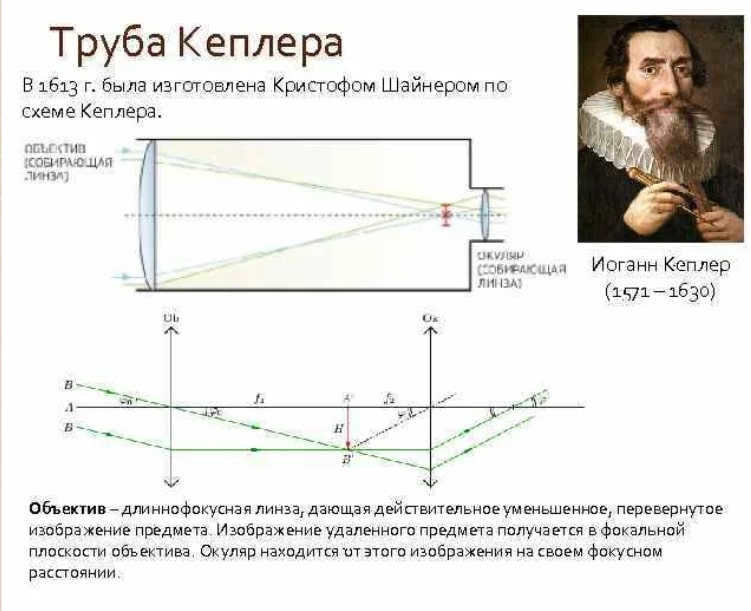
Due to his extensive expertise in optics, the renowned astronomer was able to invent the impressive telescope. This groundbreaking invention, known as Kepler’s telescope, was first developed by Christoph Scheiner in 1613. By 1640, these telescopes had become widely utilized in the field of astronomy. As a result, Galileo’s device quickly became outdated and obsolete.
Personal life
Johannes Kepler entered into his first marriage with Barbara Müller in 1597. At the time of their marriage, Barbara was 25 years old and already a widow with a daughter from her previous marriage. During their time together, the Kepler couple had a total of five children, although tragically two of them passed away in early infancy.
In 1611, Barbara fell ill with a fever. Although she was able to recover, the illness left her with epileptic seizures as a result. Meanwhile, Johannes faced another challenge as his children contracted smallpox during this difficult period. Sadly, his six-year-old son Friedrich did not survive the disease. Barbara, also weakened by the illness, passed away shortly after her son’s death.
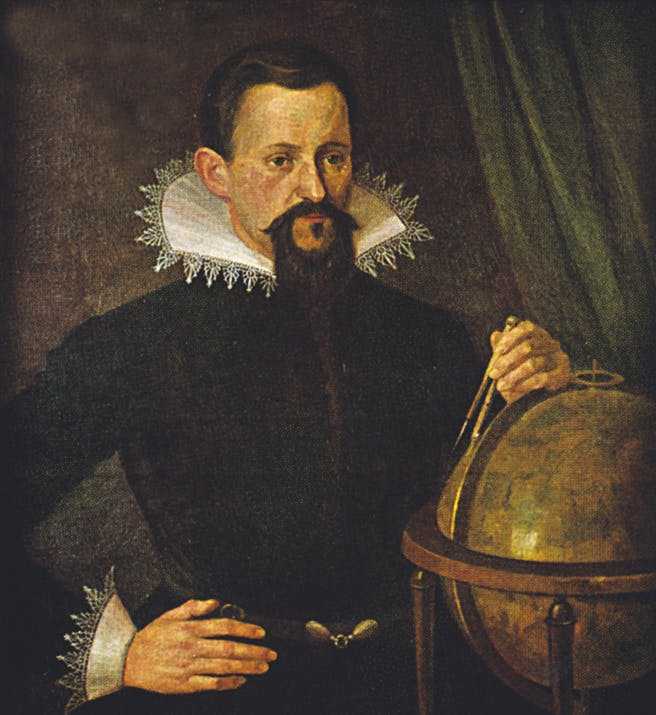
During the year 1613, Johannes Kepler entered into a second marriage. He chose Susanna, a 24-year-old woman who happened to be the daughter of a carpenter. Kepler found great happiness in this marriage, and together they went on to have six children. Susanna proved to be a compassionate and nurturing wife, showing kindness to her stepchildren.
However, Kepler’s life was not without its share of difficulties. The situation with his mother further complicated matters. His mother, a fortune-teller and herbalist, found herself in the crosshairs of the authorities, who accused her of practicing witchcraft. This was a grave accusation that carried the threat of death by burning at the stake. In 1615, Kepler received word that his mother was facing 49 charges, including witchcraft, association with the devil, spoiling, and necromancy, among others. In an attempt to save her life, Kepler began writing letters to the city authorities, pleading for clemency. Eventually, his efforts paid off, and his mother was released. However, her freedom was short-lived, as she was arrested again shortly thereafter. The trial dragged on for a grueling five years, until finally, in 1620, she was granted a trial. Kepler took it upon himself to defend his mother in court. Despite his efforts, the weary woman was only released a year later, and tragically, she passed away just one year after that.
Demise
In 1630, Kepler had to travel to Regensburg to meet with the Emperor, who owed him a salary. Johann had hoped to receive at least a fraction of it, as his family was consistently struggling financially. However, he fell ill on the way and was diagnosed with a cold. Unfortunately, he passed away shortly after.
Following his passing, his loved ones were left with a few belongings: worn-out clothes, 22 florins in cash, 29,000 florins of unpaid imperial salary, 27 already published manuscripts, and numerous unpublished ones. All of his works were later compiled and published in a comprehensive 22-volume collection.
During the tumultuous Thirty Years’ War, the cemetery where the renowned scientist was laid to rest was completely obliterated. His grave did not survive, but his self-written epitaph remains known: “I have measured the sky, and now I measure the shadows. My mind resides in the heavens, while my body rests in the earth.”
- The Enigma of the Cosmos
- Astronomical Optics
- Additions to Vitellius
- Regarding a newfound star in the constellation of Serpens.
- Novel Discoveries in Astronomy
- The Study of Dioptrics
- On the Formation of Hexagonal Snowflakes
- Copernican Astral Science
- The Harmony of the Universe
- Rudolph’s Astral Tables
- Dialogue with the Celestial Messenger
Useful Resources
Ensuring that the information we provide is relevant and reliable is a top priority for us. If you come across any errors or inaccuracies, please inform us promptly. Simply highlight the mistake and press the keyboard shortcut Ctrl+Enter.
Johannes Kepler, an exceptional German astronomer and mathematician, possessed a scientific intellect well ahead of his time. He formulated three fundamental laws of planetary motion, established that orbits follow an elliptical pattern, and made significant predictions in various scientific fields.

Johannes Kepler was born in the town of Weil der Stadt, Germany, on December 27, 1571, which happened to be St. John the Evangelist’s Day. Unfortunately, when Kepler was only 5 years old, his grandfather, who had served as a mercenary in the Spanish Netherlands, left the family. It is believed that he died during the Eighty Years’ War in the Netherlands.
Kepler’s mother, Katharina Guldenmann, supported the family by running an inn and working as an herbalist and fortune teller on the side. At the time of Kepler’s birth, the family was already struggling financially, as they had two sons and a daughter to take care of.
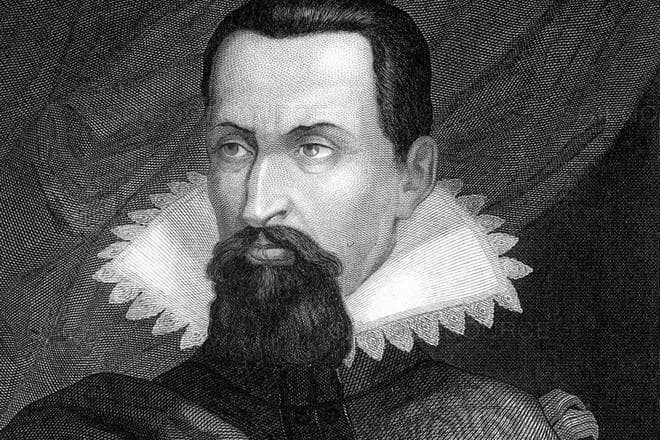
Kepler developed an interest in astronomy at a young age and quickly became enamored with the field. When he was only six years old, he had the opportunity to observe the Great Comet of 1577, thanks to his mother. In 1580, he was captivated by a lunar eclipse.
After completing his basic education, Kepler attended the theological seminary in Tübingen. Even as a young student, he demonstrated exceptional skill in mathematics and astrology. Johannes had a passion for astrology, which was considered a “pseudoscience” at the time, and he even created horoscopes for his classmates. At the age of 23, upon finishing his studies, he was appointed as a teacher of astronomy and mathematics at a Protestant school in Graz.
Science
Johannes Kepler developed his scientific worldview based on two fundamental principles: scientific and theological. As a result, his works emphasize the understanding of life’s laws through the divine, while always maintaining a commitment to scientific principles and never prioritizing religious subtleties.
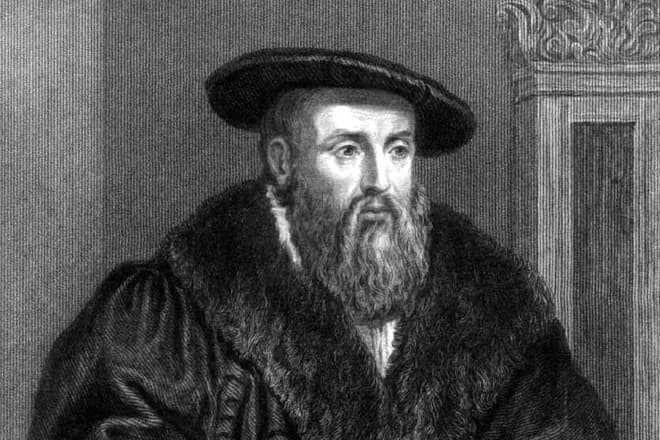
Even during his time as a student, Kepler defended the heliocentric system against his classmates, providing arguments from both astronomical and theological perspectives. In 1596, Johannes released his first significant publication, Mysterium Cosmographicum. Although the work did not immediately gain widespread recognition, it did establish Johannes as a respected figure in the field of astronomy.

Kepler reached out to various fellow astronomers, including the renowned Tycho Brahe, in search of conversation partners. Despite engaging in heated debates with Brahe, their correspondence persisted. They delved into astronomical matters, focusing on the compatibility of the Copernican theory with theology. Nevertheless, Kepler faced limitations in studying certain aspects of the discussions due to the lack of precise data, which Brahe had access to through his cutting-edge observatory at the time.
In 1599, Johannes came to the realization that his research was being hindered by unreliable data and that his work was in jeopardy due to the increasing religious conflicts in Graz. In December, Tycho extended an invitation to his associate to come to Prague, and on January 1, 1600, Kepler embarked on the journey with the hope that Brahe’s support would benefit both his scientific endeavors and his financial struggles.
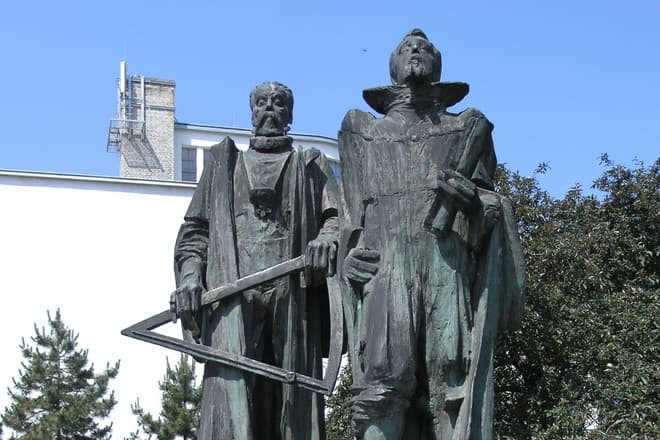
In February, Kepler had the opportunity to meet Tycho and his team. For the next two months, he stayed with the renowned astronomer, carefully examining and analyzing Brahe’s meticulous observations of Mars. By the time spring arrived, the two astronomers had established a formal partnership, and in the summer, Johann returned home to make arrangements for his family’s relocation to Prague.
Kepler faced numerous challenges in both politics and religion in his homeland, which greatly complicated his life. On August 2, 1600, he and his family were forced to leave Graz because they refused to convert to Catholicism. Shortly after, Kepler relocated with his family to Prague. In 1601, he began working for Tycho, who requested that Kepler’s colleague observe the planets and write a paper critiquing the research of Ursus, a rival of Brahe.
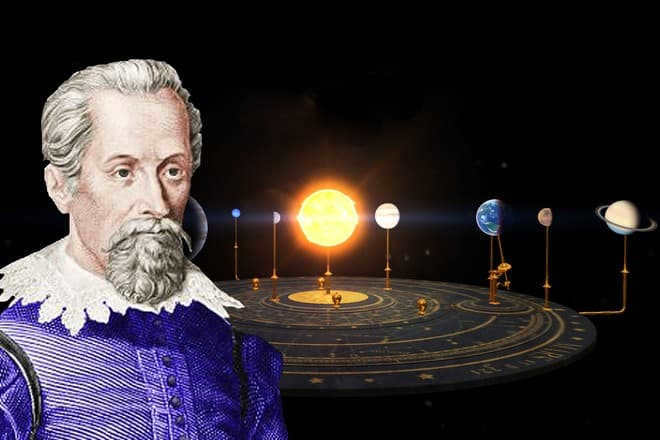
In October 1601, Tycho unexpectedly passed away, and Johannes was appointed to take his place as the imperial mathematician. He was tasked with completing Tycho’s unfinished research, which included observing Mars and creating the Rudolfine tables of planetary motion. The following 11 years proved to be the most fruitful period in Kepler’s scientific career.
In 1603, Kepler turned his attention to optical theory, drawing from his observations of the peculiar visual effects that occur during solar and lunar eclipses. On January 1, 1604, he presented his findings, outlined in his manuscript “Astronomiae Pars Optica,” to the emperor.

Within this work, the astronomer detailed the principle of the inverse squares and even propagated the findings from his examination of the human eye. Present-day neuroscientists regard Kepler as the first to comprehend that images are projected onto the retina in a reversed form. Astronomiae Pars Optica is acknowledged as the bedrock of modern optics, despite the absence of any research on the law of light refraction.
In October 1604, a fresh radiant star, SN 1604, materialized in the atmosphere, yet Kepler initially harbored doubts about the rumors – until he became convinced of their authenticity. The astronomer embarked upon methodical observations and, 2 years later, authored the publication “De Stella Nova,” in which he explored the astronomical properties of the novel celestial body.
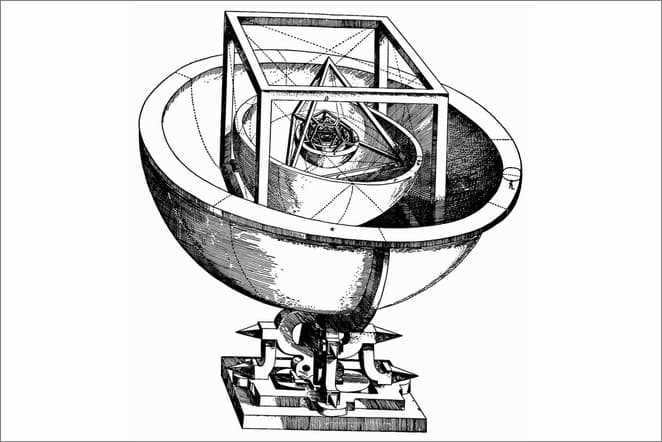
Johannes Kepler made significant contributions to the understanding of planetary motion. His groundbreaking work, “Astronomia nova,” presented the first two laws of planetary motion. Kepler’s research was based on the analysis of Mars’ orbit data collected by Brahe. However, he found both Brahe’s observations and his own conclusions to be insufficiently accurate. Through the use of mathematical methods available at the time, Kepler gradually realized that Mars’ orbit was not a perfect circle but rather an ellipse.
Additionally, by making observations of Mars, the astronomer formulated a mathematical equation that states the velocity of the planet is inversely proportional to its distance from the Sun. However, it took a significant amount of time to verify this relationship. In order to simplify the process, Kepler rephrased the proportion in terms of geometry, stating that every planet orbits in a plane that intersects with the center of the Sun. In this scenario, the radius-vector connecting the Sun and the planet traces out equal areas in equal time intervals.

Kepler authored the manuscript “Somnium” in 1611, with its publication occurring posthumously. This treatise aimed to challenge the geocentric system by presenting the practice of astronomy from the perspective of a different planet. The manuscript depicted a voyage to the moon, serving as both an allegory and one of the earliest works in the science fiction genre. From 1615 to 1621, Kepler produced three volumes of “Epitome astronomiae Copernicanae,” which extensively explored the three laws governing planetary motion.
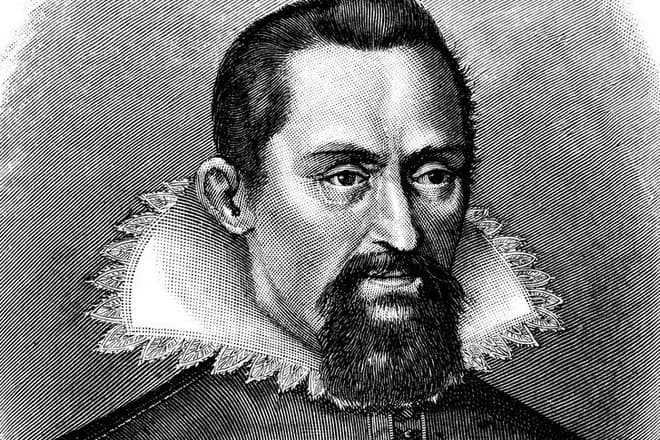
Johann made significant contributions to the fields of physics and mechanics. He was the pioneer in coining the term “inertia” and, like Galileo, formulated the first law of mechanics. Additionally, Kepler made remarkable progress in understanding the law of gravitation, although his explanation lacked a mathematical perspective. He discovered that objects with similar characteristics tend to come together, attributing this phenomenon to magnetism and the planets’ rotation around their axis.
Notably, Johannes was the first to propose that tides were caused by the gravitational influence of the moon on water. Newton reached a similar conclusion only a century later.
Life outside of work
In 1597, Johann entered into the bonds of matrimony with Barbara Muller, a 25-year-old widow who had a daughter from a previous marriage. During the early years of their union, the couple experienced the joy of bringing two children into the world, a son and a daughter. Tragically, however, both infants passed away in their infancy. Thankfully, their family was blessed with three more children in the years that followed.
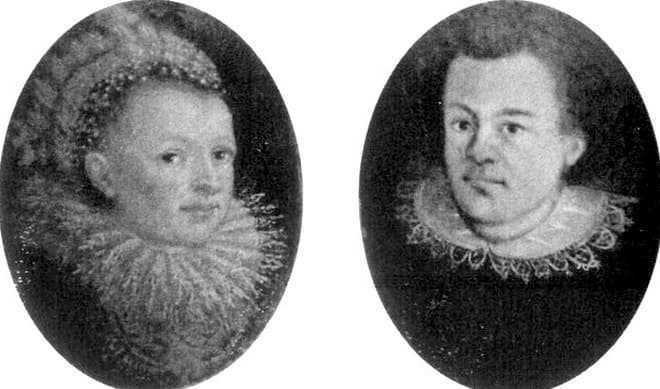

In 1611, Barbara Kepler fell ill with Rocky Mountain spotted fever. Although she eventually recovered, the illness resulted in complications, namely epileptic seizures. During this time, Kepler’s children also contracted smallpox, and unfortunately, his 6-year-old son Friedrich passed away. Barbara, who fell ill again, briefly survived her son.
Kepler’s second wife, Susanna Reuttinger, became his partner in marriage on October 30, 1613. The couple had six children, but only three of them survived. Kepler found more happiness in his personal life during his second marriage. Susanna was a kind and friendly woman who warmly embraced their adopted children.
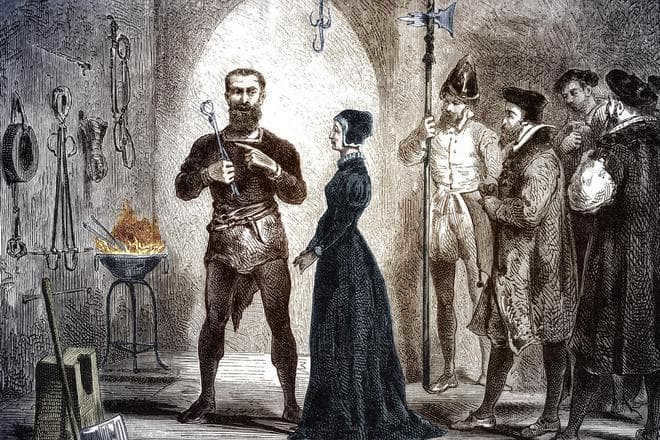
Kepler’s life was greatly affected by the circumstances surrounding his mother. This is because Katharina Kepler was known for her skills in fortune-telling and herbalism, which made her unpopular with the locals. Furthermore, it didn’t help that Johann’s mother’s aunt was executed as a witch.
In 1615, Katharina faced accusations of practicing witchcraft for the first time. However, Kepler intervened and enlisted the help of lawyers to defend her in court, resulting in her acquittal. Following this incident, Johann brought his mother to Linz, but after four years, she relocated to Leonberg where she found herself once again facing charges and subsequent arrest. Despite being chained near the city gates, Katharina refused to confess to any wrongdoing, even in the face of torture. Once again, Johann came to her defense, leading to her acquittal in 1621. Unfortunately, the toll of imprisonment and old age had taken a significant toll on Katharina’s health, and she passed away in April 1622.
During the final years of his life, Kepler traveled extensively. Unfortunately, shortly after his arrival in Regensburg to collect his salary, he succumbed to illness and passed away. It is believed that the cause of his death was a cold he caught while on the road. As part of his estate, Kepler left behind a small sum of money, numerous manuscripts, and an outstanding salary of 29,000 florins, which the emperor owed him.
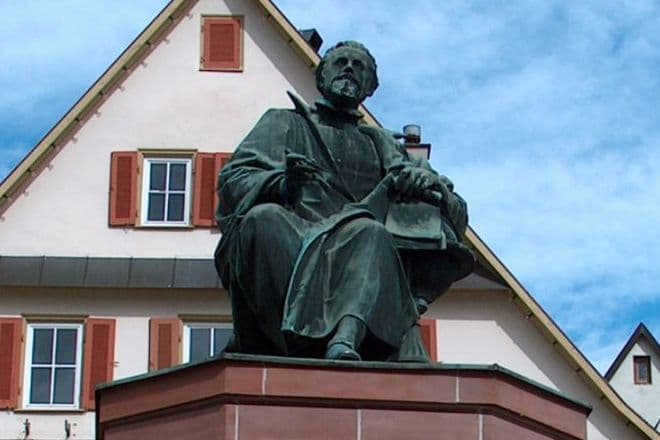
Unfortunately, Johannes Kepler’s grave was not able to be preserved as the cemetery where he was laid to rest was destroyed by the Swedish army. However, there is one thing that remains to honor his memory – the epitaph that Kepler himself composed.
Throughout history, numerous portraits of Kepler have been passed down, ensuring that his likeness is remembered. As a renowned scientist, his works have been highly regarded since their initial publications, leading to various artists depicting him, even during his own lifetime.





